This is an introduction to modern stereoscopic 3D equipment for both the home 3D video game and movie consumer, and an explanation of technology used in the professional 3D cinema space. This is also a second release candidate, and members are welcome to point out additions or points we may have missed in this thread[/b] for a future revision.
It is important to recognize that this document is intended for 2D consumers interested in learning about stereoscopic 3D for the first time, and we are working hard to make the terminology and concepts as easy to understand as possible. We would also be grateful if members can contribute artwork to help convey what these technologies are about.
What is Stereoscopic 3D, and Why Should I Care?
How Does it Work?
What Can I Use Today?
I. Anaglyph
[*]1. Red/Blue Glasses
[*]2. Dolby 3D
[*]3. ColorCode 3-D
II. LCD Shutter Glasses
[*]1. CRT Monitors
[*]2. Single Consumer Projectors (e.g. DepthQ)
[*]3. Checkerboard (e.g. Samsung, Mitsubishi 3D HDTVs)
III. Polarized Glasses
[*]1. Dual Projectors (Consumer Projectors, IMAX 3D)
[*]2. Page Flipped (Real D)
[*]3. Interlaced (Zalman 3D monitors, SpectronIQ 3D HDTVs and monitors)
[*]4. Dual Panel Solutions I (Planar)
[*]5. Dual Panel Solutions II (iZ3D monitors)
IV. Head Mounted Displays (TDVision Corp., Vuzix, Emagin)
Where Are Things Headed? (Conclusion)
[/url]
What is Stereoscopic 3D, and Why Should I Care?
3D or “stereoscopic 3D” (S-3D) technology refers to media that displays images or content in a way that lets you perceive depth the same way you do in everyday life.
The stereoscopic 3D industry is going through a very exciting time. All the leading Hollywood studios are releasing S-3D movies in specially outfitted movie theaters, and revenues earned in stereoscopic 3D cinema is easily two to three times that of traditional 2D showings. Why all the excitement? Why do these movies sell so well? S-3D adds a superior level of visual beauty and immersion in a way that greatly enhances the filmmaker’s ability to tell stories – and this is not possible through other means. If you ask any moviegoer, the words of choice tend to be “it’s so cool!”
The flip side is a large consumer S-3D movement is in play, and in addition to being able to watch stereoscopic 3D movies, gamers are now able to play their favorite titles in S-3D too! Samples of a stereoscopic 3D gaming experience would be walking through a dark cave and actually seeing the depth in the back of the scene, or taking part in an action packed space battle, and seeing explosions flying out at you. These experiences are unique to S-3D gaming, and have not been possible until now.
Sample consumer S-3D equipment include special 3D monitors, HDTVs, head mounted displays, projectors, glasses, and more. Unlike the stereoscopic solutions of the past, modern technology is backed by leading names including Samsung, Mitsubishi, iZ3D, TDVision Corp, NVIDIA, LG, SpectronIQ, Hyundai, Philips, and countless more.
[/url]
How Does it Work?
Unless you have a medical limitation, you are probably able to perceive 3D, and this is how it works:
If you close your eyes one at a time, you will see that each eye sees a slightly offset view from the other. Your brain takes the images provided by your left and right eyes, and combines them into a single picture. This picture includes the depth we all take for granted.
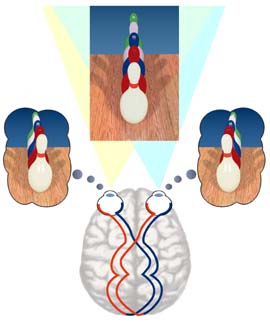
3D Explanation Sourced From HERE[/b].
To make stereoscopic 3D technology work, each eye has to receive a unique and offset image from the other eye. While there are several brands and products, they are all based on one or more of the following S-3D core technologies: anaglyph, LCD shutter glasses, polarized projection and lenses, head mounted displays, and auto-stereoscopic 3D solutions.
[/url]
What Can I Use Today?
There is a wide selection of stereoscopic 3D solutions on the market, and here is a list of what is available by classification:
[/url]
I. Anaglyph
All forms of anaglyph are based on the idea of filtering a unique image for each eye by separating the images with a selection of colors, and having the glasses differentiate the colors for each eye.
[/url]
1. Red/Blue Glasses
Anaglyph is most often associated with “red/blue” glasses. Compared to modern solutions, this is considered the worst way to experience stereoscopic 3D, but it’s very inexpensive (possibly free!) and it works.
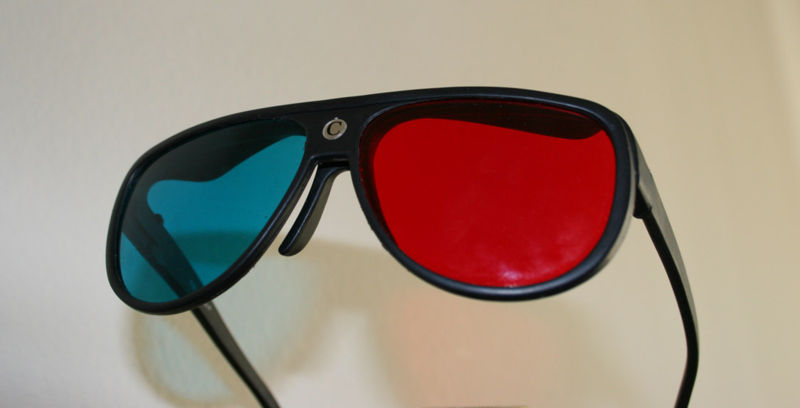
Standard Red/Blue Anaglyph Glasses
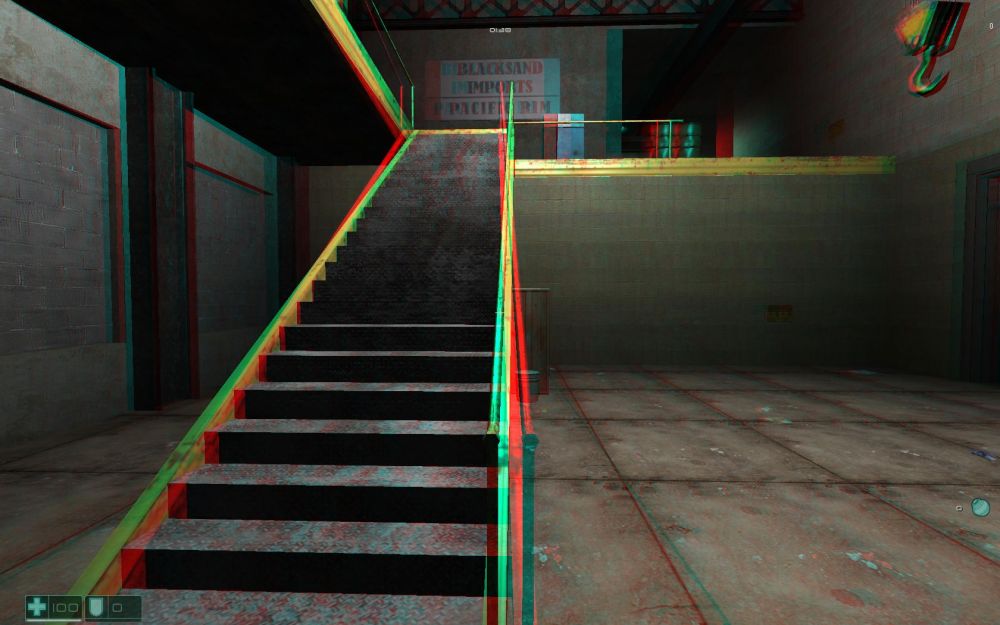
Red/Blue Anaglyph Game Image
The viewer wears special anaglyph glasses, and each eye has its own lens. Red for the left eye, and blue for the right eye. Meanwhile, the screen’s image has a red component and a blue component. Between the glasses and the image, the red components are seen by one eye, the blue components are seen by the other, and the viewer gets a true stereoscopic 3D result.
The down side of this technology is after extended viewing, you may experience headaches, your brain will temporarily distort the color spectrum your eyes are capable of seeing to compensate for the glasses, and the visual experience will not have the same color experience as originally intended.
[/url]
2. Dolby 3D
It is a misnomer to put the Dolby 3D stereoscopic 3D movie system in the anaglyph category, but it is often referred to as "anaglyph on steroids". While Dolby 3D uses color to separate the left image from the right one, this is where the similarity with anaglyph techniques ends. Dolby 3D places every color in each eye, and this leads to the required cinema grade color quality.
The system chooses a red, a green, and a blue for the left eye (RGB), and a slightly different red, green, and blue for the right eye. With RGB, it is possible to project the entire color spectrum to each eye. In order for the color difference between eyes to remain unnoticeable, the viewers’ glasses have no less than fifty filters in each lense. When both eyes are open, the viewer’s dominant eye compensates for whatever minor color difference remains.
Tim Partridge(left), Executive VP of Dolby Laboratories,
and Neil Schneider, President & CEO of MTBS (right).
Dolby 3D’s biggest selling point is theater owners can maintain their traditional white screens, but the trade-off is the glasses have been criticized for being expensive compared to their polarized counterpart. While durable, the glasses also require cleaning with every showing.
You can read MTBS’ interviews with Tim Partridge, Executive Vice-President of Dolby Laboratories HERE[/b] and HERE[/b].
[/url]
3. ColorCode 3-D
In our opinion, ColorCode 3-D is arguably a modern anaglyph solution that uses an amber/blue filter instead of a red/blue filter. Similar to traditional anaglyph, it can be viewed on almost any form of media including paper, screen, or projection. However, unlike anaglyph, the choice of filters makes the images comfortable enough to view in 2D, and equally viewable in 3D when wearing the ColorCode 3-D glasses.
The solution is cost effective, but the trade-off in our experience is the images appear to be very blue when viewed in S-3D, and the level of depth or separation (learn about separation HERE[/b]) is limited. We think that if the separation was increased to much higher levels, the stereoscopic 3D viewing would work well, but the 2D images would distort in a similar manner to traditional anaglyph.
[/url]
II. LCD Shutter Glasses
LCD shutter glasses have been available for several years now. Unlike anaglyph technology, they don’t require changing the screen color to work.
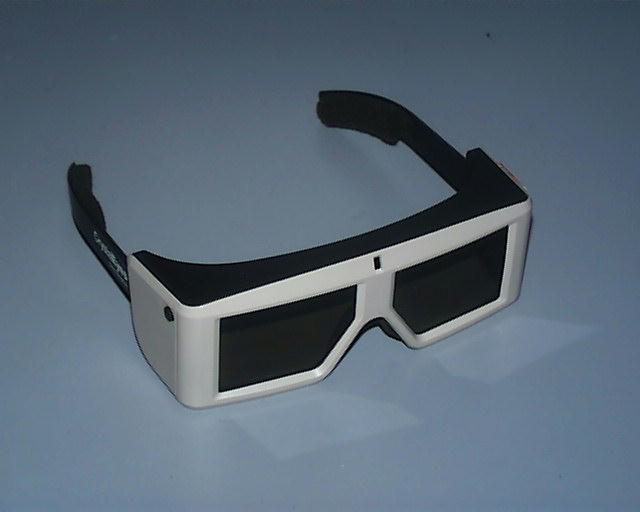
Crystal-Eyes Shutter Glasses
These 3D glasses have an LCD panel that covers the entire eye. When a panel is on, it is completely black. When it is off, it is transparent. In practice, the left eye will be transparent when the right eye is black, and then the right eye is transparent when the left eye is black. The black color is how the glasses blind each eye one at a time.
Meanwhile, the screen is flashing two alternating images to coordinate with the glasses. An image for the left eye, an image for the right eye, and back again. When set up properly, this alternating pattern happens so fast that the viewer doesn’t see any flicker or strobe effects, and they benefit from a full color 3D image. LCD shutter glasses are sometimes referred to as “active glasses” or an “active solution” because they physically change and alternate to make 3D possible.
The challenge with LCD shutter glasses is the rapid alternating between left and right images cuts the light levels in half. To get the same image quality you would normally get in 2D, you must double the brightness of your screen, and the color quality will appear tanned or brownish compared to the 3D image. There are currently three main avenues for LCD shutter glasses:
[/url]
1. CRT Monitors
LCD shutter glasses are best known for working with old style CRT monitors, but CRT monitors are no longer popular or readily available in traditional retail outlets.
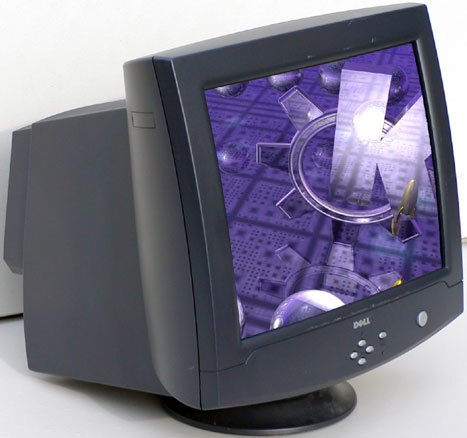
Dell CRT Monitor
Historically, the CRT monitor can be credited as being the industry’s first mass market outlet for stereoscopic 3D gaming because of the popularity of the monitors and the inexpensive nature of the LCD shutter glasses.
S-3D with LCD shutter glasses are always dependent on one thing - "refresh rate". Refresh rate refers to how many times per second the screen can update itself, and this is rated in "Hz" or "Hertz". Depending on the monitor’s size and quality, there is a fixed limit on how many times the screen can be updated. The higher the resolution, the lower the refresh rate because it takes longer for the monitor to get all the information on the screen before the next update can be displayed or the screen can be "refreshed".
In the CRT world, high enough refresh rates are required to prevent strobe or rapid flickering problems - common causes for headaches, nausea, and visual discomfort. Therefore, most if not all CRT monitors have a minimum refresh rate of 60Hz in their highest resolution, and this meets the bare minimum for a tolerable 2D viewing experience.
In the S-3D world, LCD shutter glasses work in conjunction with the CRT screen by rapidly alternating two unique pictures to create a single stereoscopic 3D image in the viewer’s brain. This means that the original refresh rate intended for 2D viewing is divided in half for stereoscopic 3D viewing, and the standard 60Hz is reduced to 30Hz per eye - well within the range of a strobing headache experience!
To compensate, CRT monitor users reduce their screen resolutions to allow refresh rates as high as 100Hz to 120Hz total so they can have a comfortable S-3D experience. Unfortunately, this usually reduces high resolution game play to modest pixel counts as low as 1024X768. Furthermore, even with 50Hz to 60Hz projected to each eye, there is still potential to pick up on some mild strobing effects.
To add insult to injury, most new S-3D gamers using the CRT solution were unaware of this refresh rate requirement, and modern stereoscopic 3D solutions are falsely associated with headaches and nausea because of the poor legacy CRT monitors left behind.
In an effort to capture the CRT monitors’ S-3D market space, you may see advertisements claiming that LCD Shutter Glasses work with LCD monitors. This borders on a false claim because LCD panels cannot refresh as fast as CRT monitors, and the success rate is very low.
Current industry changes have temporarily reduced the software support for CRT monitors in stereoscopic 3D gaming.
[/url]
2. Single Consumer Projectors (e.g. DepthQ)
There are some single projector solutions that are popular among enthusiasts that work with LCD shutter glasses similar to the way CRT monitors worked. This is more popular for commercial use than mass consumer adoption, but this can change as stereoscopic 3D becomes more popular in the consumer world.
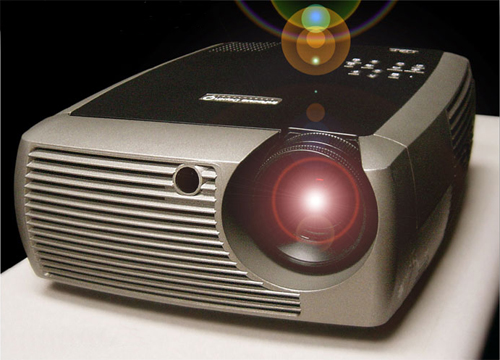
DepthQ Projector
Projectors are very exciting for gamers who can implement them because they are one of the most inexpensive ways of getting a very large and immersive stereoscopic 3D image. Imagine life sized 3D monsters on your bedroom wall – that’s what this solution offers.
The trade-offs with projectors include expensive bulb replacement, the need for space, and their limited resolutions. However, many avid 3D gamers swear by them.
Unfortunately, some industry changes have temporarily reduced the software support available for this solution combination in gaming – but we are confident this is a temporary issue.
[/url]
3. Checkerboard (e.g. Samsung, Mitsubishi 3D HDTVs)
LCD Shutter Glasses are going through resurgence with DLP, Plasma and LaserTV 3D HDTV televisions.
Similar to CRT monitors, shutter glasses alternate very quickly to project two images, but instead of rendering a complete image at a time, the resolution is cut in half and is handled in an alternating checkerboard pattern. This creates the illusion of the complete 2D resolution.
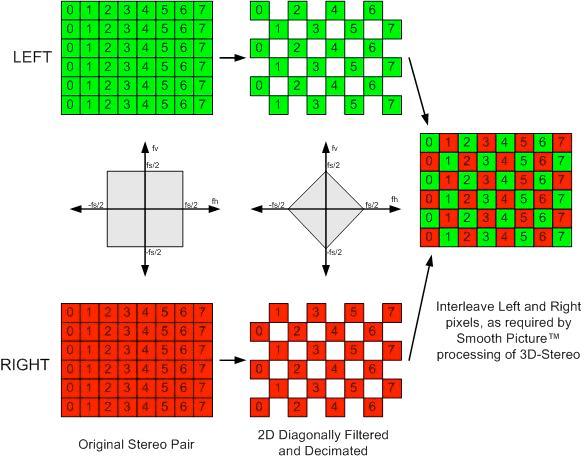
DLP Checkerboard Pattern Sourced From HERE[/b]
Fortunately, the nature of stereoscopic 3D reduces the importance of high resolution because of its volumetric nature, and the checkerboard solution does not have problems with under-detailed text that is hard to read the way interlaced solutions do. It also helps that 3D HDTV tends to be 40” or more in size, so the loss in resolution doesn’t impact the fine details the same way it would if the screens were smaller.
However, as with all LCD shutter glasses solutions there is a 50% loss of light because of the glasses’ alternating “dark phase”, and the screens can’t fully compensate for this yet.
[/url]
III. Polarized Glasses
Polarized glasses work on the premise that light can be “vibrated” a certain way, and the glasses are able to filter this “vibration” to each of your eyes. This is sometimes referred to as a “passive solution” because the glasses have no moving or changing parts, and all the real action is happening on the screen or projector.
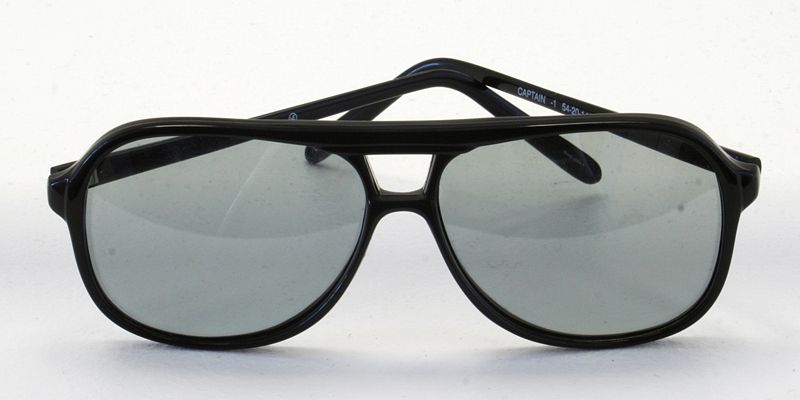
Standard Polarized Glasses
There are five current methods for this technology.
[/url]
1. Dual Projectors (Consumer Projectors, IMAX 3D)
The consumer dual projector solution requires two aligned projectors with polarizing filters pointing to a single screen. The glasses filter these images based on their “vibration” signature, and the viewers get a complete 3D image. This is a favorite solution among technically inclined enthusiasts, but is also used on the big screen by IMAX 3D.
With the exception of slightly darkened polarized glasses, there is little light reduction because there is no “black phase” on the glasses blocking out 50% of the light. This is also why IMAX 3D is able to show 3D movies on a very big screen.
The trade off is the projectors can easily fall out of alignment, and the 3D effect can be greatly undermined when this happens.
[/url]
2. Page Flipped (Real D)
Real D uses a technology where a single projector creates two images and points to a single screen to make a 3D image, but how is this possible?
Lenny Lipton(left), CTO of Real D, and Neil Schneider (right), President/CEO of MTBS.
TRIVIA: Did you know that Lenny wrote "Puff"? YES, the song that goes
"Puff the Magic Dragon lived by the sea..."
It is a similar idea to LCD shutter glasses where the screen alternately displays a left and right image very quickly and the glasses block each eye as needed. Instead of the glasses flickering on and off, there is a polarizer in front of the projector alternating between a left and right eyed filter. The audience’s polarized glasses filter these left and right images to each eye, and combined with the extremely fast rate that these images swap, you get a flicker free 3D image on the big screen.
Similar to the LCD shutter glasses, the 3D trade-off is a 50% loss of light because of this flicker between images, so the screen image size has to be reduced to compensate. There is also a requirement for the theater owner to buy a special silver screen which is expensive and dampens the color quality.
You can read MTBS’ interview with Joshua Greer, President of Real D and Elizabeth Brooks, Real D’s Chief Marketing Officer HERE[/b].
[/url]
3. Interlaced (Zalman 3D monitors, SpectronIQ 3D HDTVs and monitors)
To make a stereoscopic 3D image, there has to be two unique pictures projected to your eyes at the same time, or so quickly that they seem to appear at the same time. CRT monitors were popular because the screens could be updated very quickly for this purpose, but CRT technology is no longer in favor with consumers because it takes a lot of space, it’s heavy, and is not environmentally friendly.
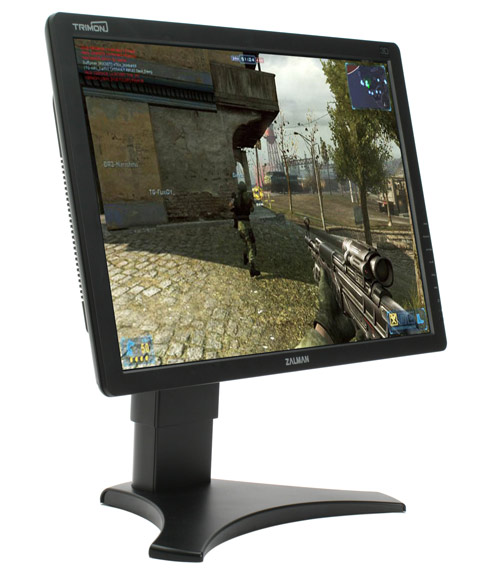
Zalman 19" 3D Monitor
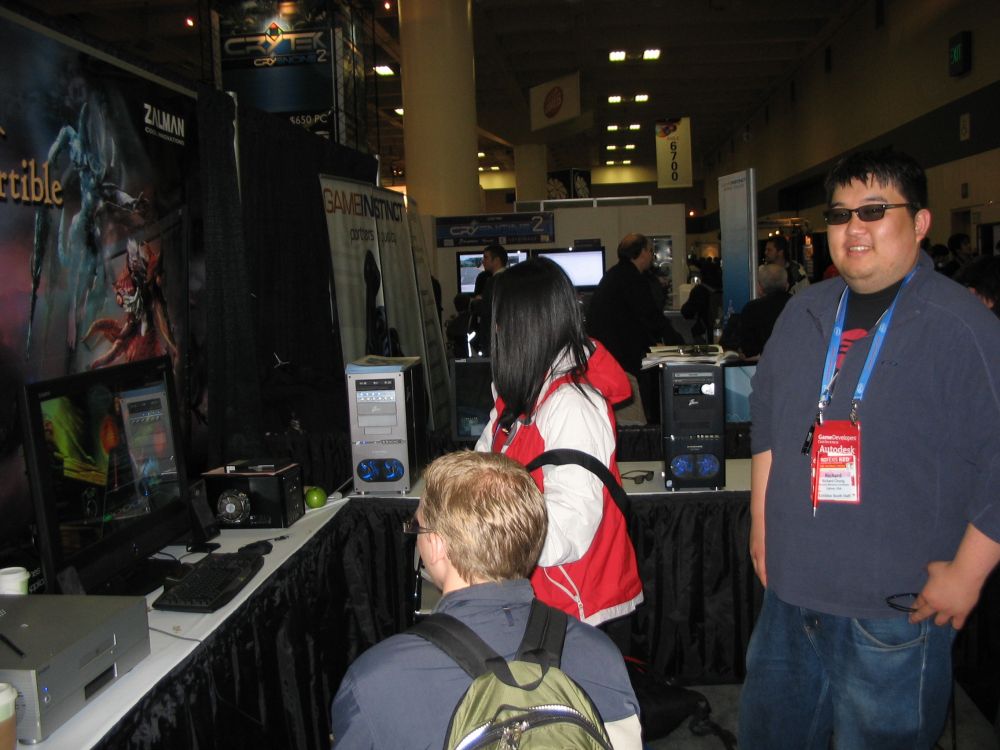
Richard Chung, Zalman Product Manager, Game Developers Conference
LCD panels have quickly taken CRT’s place, but LCD monitors don’t have a high enough refresh rate to update the screen and switch between two unique images fast enough. A popular way around this problem is to cut the vertical resolution in half with 50% of the lines devoted to your left eye, and 50% devoted to your right. A polarizing filter is then placed in front of the LCD panel to differentiate the left and right eyed resolution lines, and the viewer’s polarized glasses combine the images for a stereoscopic 3D result.
High resolution is critical in 2D, but it isn’t as important for stereoscopic 3D. Resolution is always a plus, but in S-3D, a sharp interlaced image is very rewarding. Ghosting refers to cross-talk between the eyes, or an inability for each glasses lens to completely block out the image from the opposite eye. Current interlaced 3D monitors and HDTV solutions have the advantage of displaying very little ghosting.
Another benefit is the light levels are very high compared to other solutions because the glasses and/or screen is not flickering between images or blocking the eyes in any way – with the exception of the slightly darkened polarized glasses.
A challenge with interlaced 3D solutions is while graphics tend to look very good, small text can become difficult if not impossible to read. The problem is that half the vertical resolution interferes with the fine details lettering requires. The low ghosting functionality also requires sitting in a fixed vertical position. If the viewer tilts forward or backwards a few degrees, ghosting becomes very visible. Finally, this technology is resolution specific. If your game requires a reduction in resolution to maintain performance, the image can’t be scaled to a larger size - and you will need to use a fraction of the screen space to get your games to work.
In the case of larger sized monitors and HDTV solutions, the impact of these trade-offs are greatly reduced.
[/url]
4. Dual Panel Solutions I (Planar)
While interlaced LCD technology manages to project a sharp image, professionals may need fuller resolutions for research purposes or gamers may be seeking even higher levels of detail. Instead of dividing the resolution of a single LCD panel between two eyes, an alternative is to take two full sized resolution LCD panels and project them on a central surface.

Planar 3D Monitor
This scenario works in three parts:
a. There is an LCD panel on top.
b. There is a layer of glass in the middle.
c. There is an LCD panel on the bottom.
The two LCD panels have polarizers and are projected to the center surface. The polarized eyeglasses filter each image from the center surface and the end user gets a nearly ghost free full resolution image. The trade off is one eye will be a bit darker than the other because while one image is projected on the center glass, the second image is projected through the center glass. This is a minor anomaly in exchange for a nearly cross-talk or ghosting free image.
The biggest challenges are that the technology is very expensive and it takes a lot of physical space to be properly mounted. There are similar variations where the LCD panels are mounted horizontally instead of vertically.
[/url]
5. Dual Panel Solutions II (iZ3D monitors)
A final option is to have two LCD panels and a polarizer in a single monitor casing.
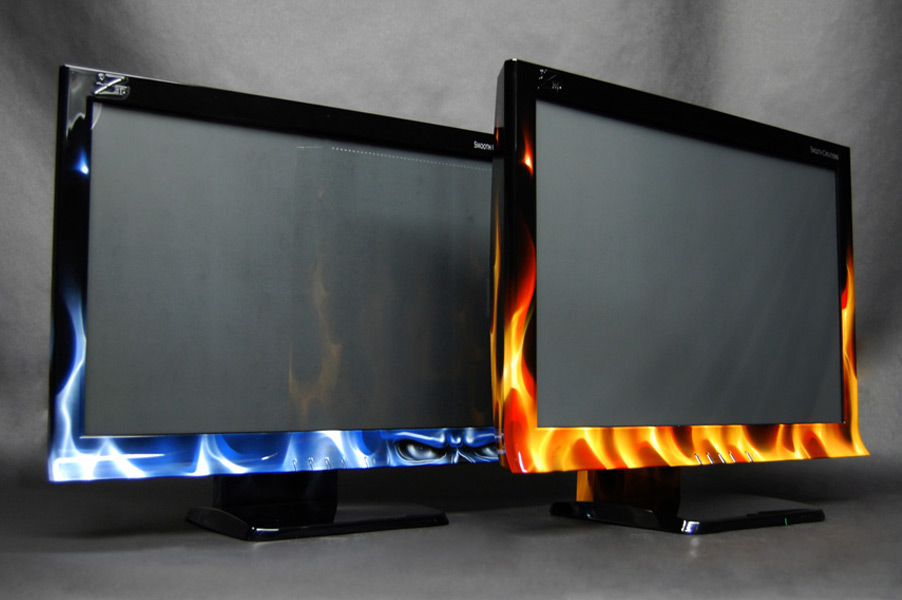
iZ3D 22" 3D Monitors (PAINTED!)
The technology works in three steps:
a. The back panel projects a left and right full color image simultaneously and controls the intensity.
b. The front panel controls the polarization on a per pixel basis with a grayscale image, and determines how much light and color needs to go to each eye.
c. The polarized glasses filter the images, and the viewers get a full color S-3D result.
This technology is advantageous because it offers full resolution results and takes nearly as little space as a traditional LCD monitor. There is no flicker between panels and it is a comfortable experience with little to no eyestrain. It is also very inexpensive compared to many of the other solutions in the market.
The trade-off is when one eye is opened at a time, it is clear that there is some ghosting or crosstalk between the images. There is also a challenge where one image can be a bit discolored compared to the other.
The reason behind this is the polarizers need to twist the light from 0 to 90 degrees to completely block and properly filter between the images, but LCD technology has inconsistencies when polarizing different colors. While the monitors don’t need to be changed, a new type of polarized glasses solution is in the works to compensate for this, and we are expecting some exciting announcements in the coming months.
In the meantime, when both eyes are open, the nature of having a dominant eye overcomes this ghosting challenge and has not proven to be a detriment to the technology.
You can read MTBS’ interview with the iZ3D team HERE[/b].
[/url]
IV. Head Mounted Displays (TDVision Corp., Vuzix, Emagin)
Head Mounted Displays, or HMD for short, is one of the oldest stereoscopic 3D technologies on the market. Unlike their predecessors, modern HMDs are lightweight helmets or headbands that place miniature screens directly in front of the viewer’s eyes.
By having the screens directly in front of their eyes in an enclosed environment, the viewer is left with the illusion that they are seeing their favorite games or movies with a very large screen. While this illusion is subjective, head mounted displays are considered one of the most immersive stereoscopic 3D experiences possible.
TDVisor Prototype

Ethan Schur (Director of Marketing for TDVision), left,
Manuel Gutierrez Novelo (President & CEO of TDVision), middle,
Neil Schneider (President & CEO of MTBS), right
Their biggest benefits include full color immersion and absolutely no ghosting. There is no ghosting because each eye is getting its own personal screen. Modern HMDs often include additional features like earphones and head tracking that adjust the game’s perspective as the viewer’s head moves.
There are a few trade-offs with this technology, though. To date, the highest resolution consumer HMD solutions are 800X600 and 640X480 pixels per eye. While still impressive to see, modern gamers are used to much higher pixel counts. TDVision Corp. is expected to be releasing a 1280 X 720 (720P) HD HMD in the coming months which is going to be a welcome addition to the consumer market.
The nature of an HMD’s immersion also causes nausea for the inexperienced gamer. When we move our heads, our brain expects our vision to correlate with our movement. When we are wearing an HMD, and the image doesn’t change according to where our brain thinks our eyes should be looking, this incongruity creates nausea.
Head Mounted Displays are one player at a time technology – so don’t expect to be sharing the experience with a group of friends at the same time. Though, having a movie theater to yourself isn’t so bad, either!
Finally, believe it or not, ghosting has its benefits. When playing video games and determining the best settings for game play, it’s much easier to see with the naked eye what 3D proportions are best because the viewer can see both images at the same time and understand how they relate to each other. Since there is zero ghosting with HMD solutions, there is no reference point to do these adjustments. It is therefore important that the stereoscopic 3D drivers give some kind of visual cue on how the S-3D settings are being handled for the most comfortable results.
You can read MTBS’ interview with TDVision Corp.’s CEO Manuel Gutierrez Novelo HERE[/b].
[/url]
Where Are Things Headed? (Conclusion)
The stereoscopic 3D market is developing very quickly with countless prototypes being announced regularly. Sample technology in the works include auto-stereoscopic solutions that don’t require glasses to see in S-3D, and LCD panels with extremely high refresh rates for the benefit of LCD shutter glasses.
Similar to the way Bill Gates expected the PC to be on every desktop, MTBS was founded on the expectation that stereoscopic 3D, in one form or another, will be on every desktop and in every living room. Given the wide selection of available technologies, let alone the multiple name brands getting involved with this growing industry, it should be clear that S-3D is quickly developing into a form of mass market media.
Please post your thoughts on this guide HERE[/b], and feel free to suggest additions and corrections if needed.
Part two of this guide is going to focus on stereoscopic 3D software solutions, what’s available and their core features.
Read full article...
